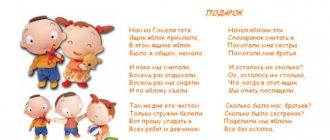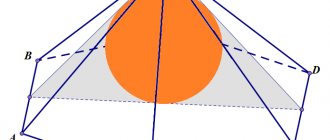Project “In the World of Numbers”
Slide 1
Completed by students of the “Erudite” club of Buturlinovskaya secondary school No. 4 In the world of numbers!
Slide 2
Project goal: 1. Learn as much as possible from the history of numbers. 2. Explore the influence of numbers on a person’s destiny. 3. Try your own abilities in writing or other creative work.
Slide 3
How people learned to count. The ancient people had nothing but a stone ax and skin instead of clothing, so they had nothing to count. Gradually they began to tame livestock and cultivate fields; trade appeared, and there was no way to do without counting. At first they counted on their fingers. So, for example, wanting to exchange a spear with a stone tip that he had made for five skins, a man would put his hand on the ground and show that a skin should be placed against each finger.
Slide 4
One five meant 5, two meant 10. When there were not enough arms, legs were used. Two arms and one leg – 15, two arms and two legs – 20.
Slide 5
How people learned to write numbers. The ancient Egyptians wrote very complex, bulky signs instead of numbers on very long and expensive papyri.
Slide 6
Egyptian hieroglyphs:
Slide 7
We tried to write the number 1289 in the Egyptian way and this is what we got:
Slide 8
Egyptian hieroglyphs have also been preserved on the sphinxes standing in St. Petersburg on the banks of the Neva. These sphinxes (an image of kings in the form of a lion with a human head) were found during excavations in Egypt in 1819 and brought to St. Petersburg in 1832. They were carved from the most durable red granite and endured the terrible heat of Egypt and the cold of the North.
Slide 10
The Arabs were the first to borrow numbers from the Indians and bring them to Europe. A little later, the Arabs simplified these icons, they began to look like this. Almost all are similar to our numbers. Among the Arabs, zero, or “empty,” was called “sifra.” Since then, the word “digital” appeared. True, now all ten icons for recording numbers that we use are called numbers.
Slide 11
When counting, the Indians and peoples of Ancient Asia tied knots on laces of different lengths and colors. Some rich people had several meters of this rope “counting book” accumulated, try it, remember in a year what four knots on a red cord mean! Therefore, the one who tied the knots was called a rememberer.
Slide 12
It was very inconvenient to store clay tablets, knotted ropes and rolls of papyrus. And this continued until the ancient Indians invented their own sign for each number. This is what they looked like
Slide 13
The Romans introduced the decimal number system. Roman numerals are still used in watches and for table of contents in books. I II III IV V VI VII VII VIII IX X.
Slide 14
To designate large numbers, the Slavs came up with their own original way: Ten thousand - darkness, ten topics - legion, ten legions - leodr, ten leodr - raven, ten ravens - deck. This way of notating numbers was very inconvenient.
Slide 15
Therefore, Peter I introduced the ten digits familiar to us in Russia, which we still use today.
Slide 16
In America, a prize has been announced for the author who will write the book: “How did a man live without mathematics?” And what? The award has still not been issued. Not a single author has been able to depict the life of a person without mathematical knowledge. But in South America, on the banks of the Amazon River, an Indian tribe was discovered that knows only 1, 2 and 3 from numbers.
Slide 17
“Magic number” of a person We learned: ancient scientists believed that numbers have a mysterious, magical meaning and influence a person’s fate. According to the beliefs of the ancients, every person has a certain number that has mystical powers, influencing character and habits. In numerology, the science of numbers, the first 9 numbers from 1 to 9 are used. And the numbers 11 and 22. These numbers are Master numbers. 1, 2, 3, 4, 5, 6, 7, 8, 9, 11, 22.
Slide 18
Meaning of numbers Number 1 - people with number one prefer to be leaders, love power and always believe that they are right. They go to their goal over people's heads. They show aggressiveness. Number 2 is the number of partnership, diplomacy. Such people often act as peacemakers. Twos prefer that everything is like everyone else's; they try to please everyone without exception. Number 3 means instability. It combines talent and cheerfulness and symbolizes adaptability. The number 5 symbolizes risk. This number is both the happiest and the most unpredictable.
Slide 19
The number 6 is a symbol of reliability. It is in harmony with nature. This is the perfect number. Number 7 - the number symbolizes mystery, as well as study and knowledge. Number 8 is the number of material success. It means reliability brought to perfection, balance. Number 9 is a symbol of universal success. It unites the features of an entire group. Meaning of numbers
Slide 20
Each person has his own main number. We decided to calculate the “magic numbers” for the students in our class and did a little research. I started with myself. Our research. 1 2 3 4 5 6 7 8 9 11 22
Slide 21
Your “main number,” which influences a person’s destiny and determines his character and capabilities, can be calculated by the day, month and year of his birth. I was born on December 22, 2004 (12/22/2004). We add all these numbers together: 2+2+1+2+2+4 Then we add the digits of this number together and it turns out - 13. We also add these numbers. It turned out - 4 This is my main number. If at some stage you get 11 or 22, then these numbers cannot be added because these are special numbers and they give a person certain abilities. Our research
Slide 22
So my number is 4. This is the number of a workaholic. 4 always finish everything. They love order, work slowly and painstakingly. I compared this characteristic with what my class teacher indicated.
Slide 23
Characteristics of the class teacher Sasha is a responsible, neat person. She studies well, is diligent, but touchy... Conclusion: it turns out that my characteristics coincide with the number of fate. And then we decided to determine the numbers of my classmates and compare these numbers with their character traits. This is what we got.
Slide 24
The influence of numbers on a person’s destiny. F.I. Date of birth Number of fate Filimonova Varya 03/25/2005. 8. Romanova Alena 04/04/2005. 6. Sharova Nastya 07/25/2005. 3. Shinkaren ko Lena 07/27/2005. 5.
Slide 25
Correspondence of number - fate and character. F.I. Destiny number Characteristics Coincidence Shinkaren Ko Lena 5. Sociable, attentive, friendly, always in a hurry. + Nastya Sharova 3. Curious, a combination of talent and cheerfulness +
Slide 26
Correspondence of number - fate and character. F.I. Number of fate Characteristics Coincidence Filimonova Varya 8. Reliability, balance, decency. + Alena Romanova 6. Loves to draw, is sociable, and has a quick temper. +
Slide 27
Conclusion And from the presented tables it is clear that the characteristics of a person coincide with what is characteristic of the number - fate. Teachers even became interested in my project and asked to determine their number.
Slide 28
We told you about the magic of numbers and how people learned to write numbers. We also decided to experiment with numbers. Here are our drawings.
Slide 34
Conclusion. Working on the project allowed us to learn a lot about the history of numbers. But we especially enjoyed working on the “Magic of Numbers” section of the project. To do this, we read an interesting book “Magical Numerology”. By Richard Webster.





